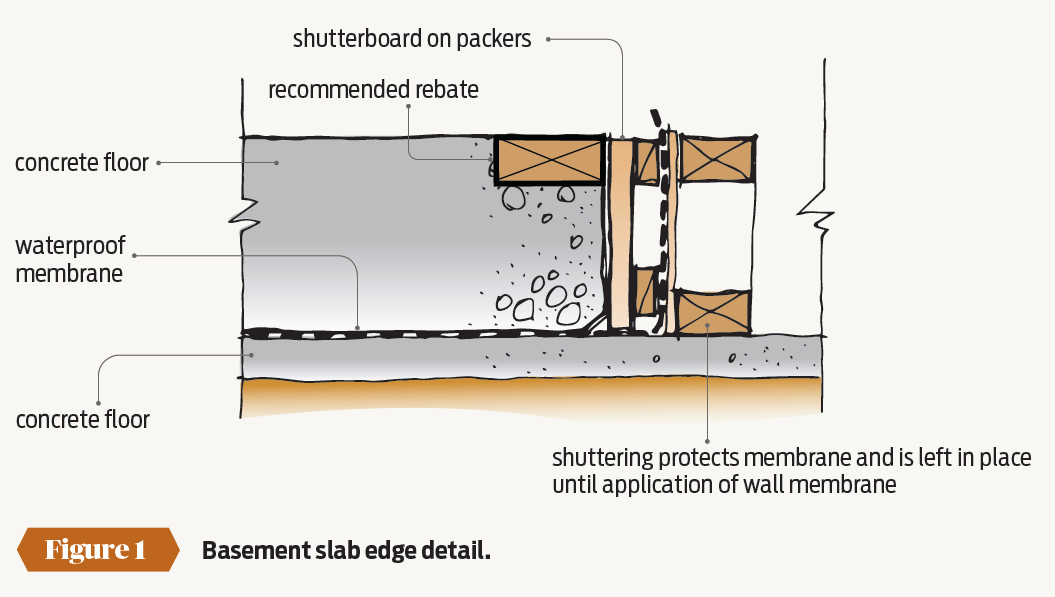Basics of building down
11 Nov 2014, Featured, Prove Your Know How, Technical

Once you start building below ground, the level of complication increases. With little opportunity to make repairs, getting the damp-proofing right the first time is critical
Leaks through basement walls below ground level can be extremely difficult to repair or locate. In some situations, part-height basement walls support the concrete slab of an upper floor, and the backs of these walls are impossible to access for repair once the floor slab has been poured.
Limited to one level
This article covers damp-proofing of domestic basements on sloping sites that are no more than one level below natural ground and are not subject to hydrostatic pressure from groundwater. Typically, they are garage spaces but may incorporate habitable spaces. Construction is usually a concrete slab on ground with concrete masonry, in situ concrete, precast concrete or grout-filled poly-block walls.
These recommendations do not apply to basements that are:
- More than one floor below ground.
- Subject to hydrostatic pressure.
- Continually wet.
Basements that fit any of these descriptions require a specifically designed tanking system.
Building Code references
A performance requirement of Building Code clause E2 External moisture is that walls, floors and structural elements close to or near the ground must not absorb or transmit moisture in quantities causing undue dampness and/or damage to building elements.
Clause B2 requires a durability of not less than 50 years for the waterproofing, as it is difficult to access once the building is completed. This means that the walls and slab need to be damp-proofed.
There are no solutions given in Acceptable Solution E2/AS1, so all damp-proofing systems for basement walls need to be submitted for consent as an alternative method. However an Acceptable Solution for basement waterproofing details is given in Appendix A of NZS 4229:2013 Concrete masonry buildings not requiring specific engineering design.
Damp-proofing walls
There are a range of options for damp-proofing basement walls, including:
- Liquid-applied bituminous coatings – brush, roller or spray application of:
– epoxies
– bitumen emulsions
– polyurethanes - Torch-on modified bitumen sheet.
- Self-adhesive modified or rubberised bitumen/asphalt sheet with self-adhering laps.
- Bentonite.
- Trowel or spray-applied cementitious (sometimes resin-modified) slurry.
Damp-proofing under the floor
Damp-proofing options for slabs on ground are typically:
- Polythene sheet.
- Proprietary concrete underlays.
- Torch-on modified bitumen sheet.
- Self-adhesive modified or rubberised bitumen/asphalt sheet with self-adhering laps.
- Bentonite.
“This article only covers damp-proofing of domestic basements on sloping sites that are no more than one level below natural ground and are not subject to hydrostatic pressure from groundwater
Required performance levels
For concrete slab underlays or damp-proof membranes (DPMs) NZS 3604:2011 Timber-framed buildings specifies a maximum water vapour flow resistance of 90 MNs/g when tested in accordance with ASTM E96. NZS 4229:2013 specifies the same level of performance for wall damp-proofing material.
Problem areas to watch for
Complications that arise when waterproofing basements include:
- Ensuring the continuity and compatibility of the damp-proofing between horizontal and vertical surfaces.
- Restricted/constricted working spaces adjacent to walls.
- Presence of water, particularly if subject to hydrostatic pressure.
- Ensuring drainage of water from behind the walls.
- The depth below natural ground.
- Retaining unstable excavations.
- Terminating the damp-proofing at or above the ground level.
- Factors that can influence the performance of the damp-proofing include:
- Incorrect product selection for the situation or substrate.
- Incompatible wall and underslab damp-proofing that does not allow a sealed junction between the two.
- The quality of the installation.
- Damage to the damp-proofing during the backfilling.
- Attempting to do the damp-proofing as cheaply as possible.
- Contamination of the surfaces and materials due to the close proximity of banks and dirt
- Material incompatibility.
A solution
The ideal solution is to specify the same damp-proofing material for the wall and under the slab to ensure compatibility. Also specify the protection board recommended by the damp-proofing supplier – proprietary protection boards are available that are designed to allow drainage, meaning water is less likely to impact on the damp-proofing itself.
Figures 1 and 2 give one option to ensure the continuity of the damp-proofing between the floor and the wall.
Figures 3 and 4 show the entire wall using a path adjacent to the basement wall, to allow the wall damp-proofing to be terminated at ground level.
Register to earn LBP Points Sign in







